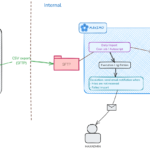A client recently asked me for a solution for importing fuel consumption data. Each day, their operators would refuel about two hundred cranes and vehicles. They enter the data in an Excel file hosted on SharePoint. The finance team has to manually key the data into Maximo from these files. The process takes a few hours each week. The client asked if we could build some integration or custom app that can automate the process.
After looking at various more complex options, we ended up using Maximo’s standard import function. The accountants have to copy and paste the data from Excel to a defined template and then import it into Maximo. The time it takes was reduced to a few minutes. Everyone is happy. The Maximo administrator is happy because this is a maintenance-free solution. The accountants are obviously happy as this helps with one of their most tedious tasks. Neither the finance team leader nor the Maximo administrator were aware of this standard capability. They started discussing applying it to applications like Purchase Orders and Invoices. From a few other recent conversations, I realised many Maximo users are not aware of some basic but useful features and tools. This post hopefully will help close some of this gap.
Import/Export function
We can upload/download almost anything using the standard Import and Export functions. They are not enabled by default in most applications as they require some configuration. As such, most Maximo users are not aware of this. In the cases where the Import/Export feature is being used, the users often don’t know how flexible this can be configured to address complex requirements. We can even customise the inbound/outbound processing rules to perform data transformation.
As an example, for the above scenario, I set up a template that has almost the exact columns as the current Excel data file the operators are using. This allows the accountants to copy/paste the data from the Excel file to the import template in just a few clicks.
For more details about this function, you can refer to the video below from Starboard Consulting:
Default Insert Fields
This is the feature I love the most in Maximo. Unfortunately, I found it is not used in most companies I had the chance to work with. Earlier in my career, when I did a lot of greenfield implementations, this was the first thing I talked about when discussing screen design. It is so useful that it helped minimise a lot of resistance from the procurement and logistics users when Maximo was introduced to them. When creating a Purchase Requisition or issuing material, the data fields are usually repetitive.
For example, in a material issue transaction, the lines usually have the same charge details like work order, asset, and GL account. By putting these details in the default insert fields, the user will only have to enter the item number and quantity for each line. You can refer to the short demo below to see how it works:
“Stupid” Smart Fill / Type-Ahead / Asynchronous
In Maximo, there are various features we can tweak to increase data entry speed. Some of them are:
- Smart-Fill: for a look-up field, such as Item Number, if you type BEAR, and there is only one item that matches the first few characters, such as BEARING1001, it will fill the whole value for you. However, the issue is when you type an exact item number, if there is more than one option that partially matches the word, it will show a magnifying button, forcing the user to click and select. This means the user has to move his/her hand between the keyboard and the mouse. By turning “Smart Fill” off on a field, it accepts the exact value you entered without questioning. I once helped turn this off on the Bin Number field for the Inventory Issue/Transfer screens. It only took a minute to make the change, but it made the user “exceedingly happy”. That exact word she used when giving feedback to my boss. Below is a quick demo of the difference when turning “Smart Fill” off:
- Type-Ahead: after typing a few characters, Maximo will show a list of available options for you to pick from. This needs to be configured to work.
- Asynchronous Data Validation: after updating a field, the user can move and update the next field instantly without having to wait for the server to validate the data. However, the validation is almost instantaneous in most cases, and there is no benefit from this feature. On the other hand, after entering an invalid value, the user has to update another field to see the error message. This is actually can be counterproductive and annoying. The key takeaway here is that if you don’t like this behaviour, we can easily turn it off locally for certain fields, or for the whole system.
Bulk Update From List screen
Many good applications provide the user with the capability to bulk-apply changes to multiple records. Unfortunately, Maximo doesn’t provide this as a standard feature. The good news is it’s easy to implement this bulk-apply function to the List screen. In the past, this required some Java customization. In newer versions, we can set it up with Automation Script. Below is an example of how it can be implemented to mass update work order scheduling details. This is probably the most common requirement for bulk updates in Maximo. I built this to demonstrate this point which took me less than 30 minutes by following this excellent tutorial.
MXLoader
MXLoader is a data upload/downloading tool written by Bruno Portaluri. It runs on top of Excel and is free to use. In case you don’t know what it is, below is a short introduction video. The only complaint I have about this tool is that it is too powerful. With MXLoader, we can update almost anything in Maximo. This can be a concern in terms of data security and integrity. Since it’s too easy and fast to mass update data, the damage is multiplied when the user makes a mistake. Other than that, for data entry, nothing beats the efficiency of feeding data directly from Excel to Maximo.
Conclusion
This post does not introduce anything new. My goal is to remind you that if you are a Maximo user who has to do a lot of data entry, speak to your Maximo support people. There are simple tricks they could do to improve your experience. If you think data entry in Maximo is a pain in the neck and they don’t have an answer, shout at them, bully them, or threaten to fire them. People often find creative solutions under pressure. Cutting down a few clicks doesn’t sound like much, but if you have to enter a few hundred lines of data, it can make a big difference. If you have any other data entry problem that can’t be addressed by the tricks mentioned above, please share in the comments. I will see what else can be done to address it.




